Universal DH: Winners, losers when NL adopts the rule

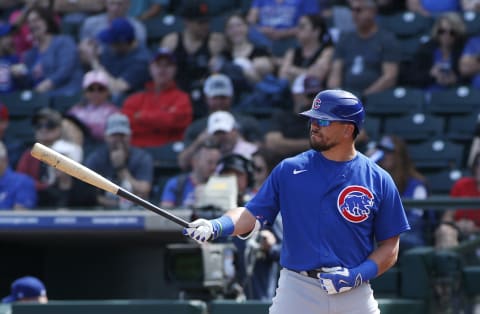
Some NL teams are better-positioned than others to take advantage of the universal DH rule in a shortened 2020 season. Let’s take a closer look.
Among the few things certain about this coming baseball season – assuming there is one – is that the National League would adopt the designated hitter rule (aka Universal DH).
The rationale is to lighten the load and protect the futures of pitchers who may be asked to do more on the mound during a shorter, more intense schedule.
More from Call to the Pen
- Philadelphia Phillies, ready for a stretch run, bomb St. Louis Cardinals
- Philadelphia Phillies: The 4 players on the franchise’s Mount Rushmore
- Boston Red Sox fans should be upset over Mookie Betts’ comment
- Analyzing the Boston Red Sox trade for Dave Henderson and Spike Owen
- 2023 MLB postseason likely to have a strange look without Yankees, Red Sox, Cardinals
But that raises the question of which National League teams would stand to benefit most strongly from the immediate imposition of a DH rule. The teams’ roster, obviously, was created over the winter with no expectation that a universal DH might come into play for more than the 10 or so times NL teams find themselves playing inter-league road games.
With spring training possibly re-opening in a month, it’s a good time to consider which teams – by planning or fortune – appear to be best positioned to adapt to such a meaningful rule change.
Some are better positioned than others merely because they are more fully stocked with offensive talent. Others have positional overloads that can be alleviated by moving a potential bench-warmer into a DH slot.
At the other end of the scale, the talent bases of some NL teams simply are too imperfectly established to comfortably incorporate a universal DH rule. Those teams could be hurt by the rule change.
What follows is a look at the rosters of all 15 NL clubs with an eye toward DH candidates. The clubs are listed in a rough order approximating the ease with which they could transition to a full-time DH, those teams having the easiest time listed first.
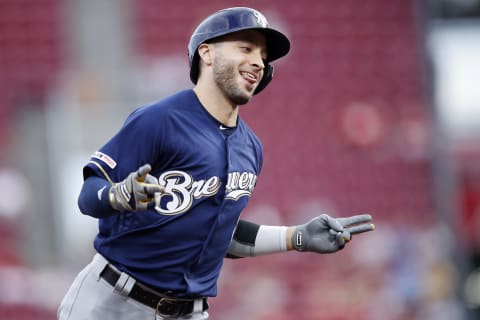
Universal DH: Winners and Losers in the NL
Milwaukee Brewers
The Brewers’ decision should be easy. Ryan Braun is a 36-year-old team legend who is gracefully aging out of his every-day usefulness as an outfielder.
Braun can still hit. He batted .285 with 22 home runs and 75 RBIs in 2019, his best season in three years. But the defensive metrics turned negative on Braun three seasons ago, and they have not come back.
Beyond that, the Brewers have positioned themselves over the past two winters to rely less on Bran’s defensive skills.
In December of 2018, they acquired Ben Gamel in a trade with Seattle. Although hardly a defensive whiz, Gamel is better than Braun. He appeared in 108 games last season, all in the outfield, and although he divided that work covering for Braun, Lorenzo Cain, and Christian Yelich, there’s nothing that says Cain or Yelich need regular assistance.
The only downside is that Gamel batted just .248 for Milwaukee in 2019, which didn’t provide the Brewers a lot of motivation to lean harder on him this year. But the Brewers buttressed that this winter, signing free agent Avisail Garcia.
With Tampa Bay in 2019, Garcia batted .282 in 125 games. He also hit 20 home runs, both figures very much in line with his career production.
So between Garcia and Gamel, the Brewers should be well-covered in they do the obvious and turn Braun into a full-time DH.
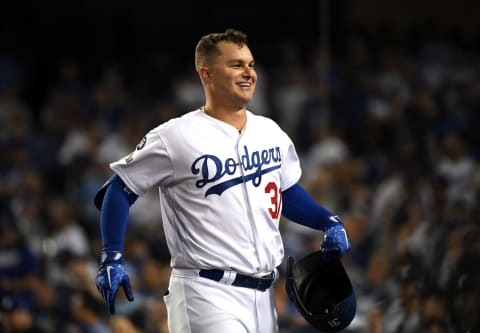
Universal DH: Winners and Losers in the NL
Los Angeles Dodgers
The Dodgers have so much talent under contract that they almost need a DH just to be able to spread the opportunities around.
When they acquired Mookie Betts this past winter, that threatened to slice into Joc Pederson’s playing time. They were already committed to A.J. Pollock in left field, and nobody was dislodging Cody Bellinger in center. Beyond that, Enrique Hernandez and Chris Taylor are both perfectly competent outfield backups.
So unless you think Gavin Lux is going to flame out at second base, forcing Max Muncy back to second and Bellinger back to first, there simply was no space in the lineup for Pederson.
With a DH, Pederson’s power comes into play again. Although not a high-average threat – he’s a career .233 stick – Pederson hit 36 home runs last season and slugged .538. Those numbers have to play somewhere, and since he’s not exactly renowned for his glove – Pederson’s defensive stats have been perennially negative since 2017 — DH is the logical spot.
Beyond that, there is room for an optimist to see Pederson’s offensive growth potential. He did, after all, hit a career-high .249 in 2019 with a career-high 74 RBIs. If he can make further incremental improvements there and reduce his 22 percent strikeout rate – that may be asking too much – Pederson could yet be what he was expected to be when he came up, a legit offensive threat.

Universal DH: Winners and Losers in the NL
Chicago Cubs
Half the media experts in captivity have spent four years begging the Chicago Cubs to trade Kyle Schwarber to an American League team so he could DH. Now they don’t have to, meaning the experts will have to find something else to write about.
Since his arrival in 2015, that’s basically been Schwarber’s spot whenever the opportunity arose; he has DH’d in the large majority of Cubs American League road games every season for which he was healthy except 2019 when Joe Maddon tended to leave him in left field.
He’s also been successful at it. In 22 games as a designated hitter, Schwarber has a career .299 average with 9 home runs – about 1 in every 10 official at-bats — and 20 RBIs. His slugging average is .678. In all other starting roles, Schwarber is a career .232 hitter with a .479 slugging average.
Locking Schwarber in as the DH would require the Cubs to commit to another left fielder. The obvious candidate is Ian Happ, who is presently slated to share time in center field with Albert Almora.
The only problem is that neither Happ nor Almora has established the consistent ability to hit at the big league level, which is the reason the Cubs had planned to hedge their bets by not committing to either one full-time in center. So designating Schwarber as the DH forces the Cubs to double down on their previously hedged bets on both Happ and Almora.
There is one other option, but it would be a controversial one. Victor Caratini is an offensively capable backup catcher to Willson Contreras who hit .266 with 11 home runs in roughly one-third of the season he played in 2019. Caratini is also an average backstop at best who does not appear to be a threat to base-stealers.
But using Caratini as a DH would mean finding another backup to Contreras at catcher, and the Cubs’ most likely candidate for that role is Josh Phegley, a non-roster invitee who hit .239 last year in Oakland.
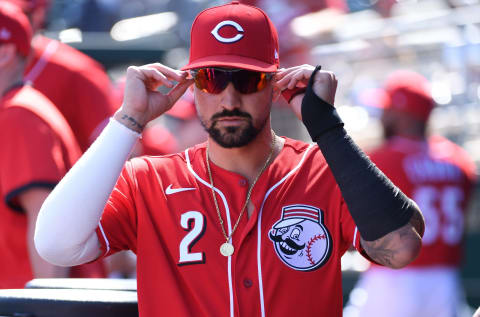
Universal DH: Winners and Losers in the NL
Cincinnati Reds
Few teams would approach the question of who to plug in at DH with as many options as the Reds.
Begin with Nick Castellanos, a free agent outfielder the Reds signed over the winter. Castellanos hit .289 with 58 doubles and 27 home runs for the Tigers and Cubs last season. Although signed as a right fielder, he’s also widely recognized as a defensive liability.
And since the Reds also signed Japanese free agent Shogo Akiyama, they’re covered defensively if they want to limit Castellanos to full-time DH duty.
Or they can leave Castellanos in right and give the DH job to Aristides Aquino, who proved alternately volcanic and glacial in a 2019 tryout. Following his Aug. 1 callup, Aquino hit a dozen home runs in his first 22 games.
Two weeks into his career, Aquino was batting .429. But one month later, after National League pitchers began to figure him out, Aquino’s average had fallen more than 150 points, close to the .259 mark he finished at.
He batted .196 during September.
The Reds also have Jesse Winker, an outfielder with DH possibilities if they decide to leave Castellanos in right, Nick Senzel in center and Akiyama in left. Finally, if Akiyama and/or Aquino shows up and they think it makes defensive sense to do so, the Reds can shift Senzel into second base and use free-agent signee Mike Moustakas as DH.
Somewhere amidst all those options, the Reds are virtually certain to find a workable plan.
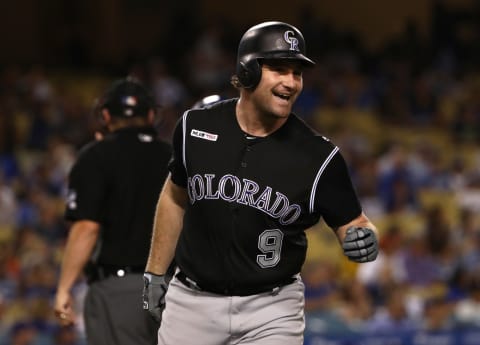
Universal DH: Winners and Losers in the NL
Colorado Rockies
Daniel Murphy came to the Rockies prior to the 2019 season on a three-year, $30 million deal. Given his mid-30s age and his long-standing reputation as an indifferent second baseman, there was never much expectation that Murphy would earn his keep by bolstering Colorado defensively.
The arrival of a full-time DH in the National League is made for Murphy.
He played in 132 games with the Rockies last season, but almost all of them were at first base. Murphy showed that he can still hit, batting .279 with 13 home runs and 78 RBIs.
The Rockies are still penciling Murphy in as their first baseman in 2020, but that’s largely because at the cost of his contract they need to plug his bat in somewhere. Statistically, Murphy was a modestly positive first baseman in 2019. Still, modestly positive fielding first basemen are a dime a dozen, and the Rockies suspect they may have Murphy’s replacement on hand in Ryan McMahon.
McMahon hit .250 with 24 home runs and 83 RBIs last year. He was stationed mostly at second base because Colorado’s original hope for that position, Garrett Hampson, flopped in his bid to take that spot. Hampson is a skilled middle infielder, but as a 2019 rookie, he batted .247 with just eight home runs in 27 plate appearances.
So what the Rockies really need is for Hampson to establish that he can be an every-day second baseman. That enables them to shift McMahon to first and Murphy to DH, tightening the defense, justifying the expense of having Murphy and making everybody happy.
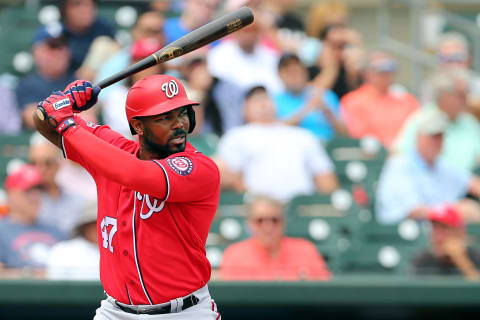
Universal DH: Winners and Losers in the NL
Washington Nationals
The World Series winners have enough veteran options that they can essentially rotate the DH spot.
Start with Ryan Zimmerman. He hit .257 in part-time duty at first base last year, and at 35 with a bad arm, he’s more than ready for lighter defensive duty.
Eric Thames signed as a left-handed power source at first base. Thames hit 25 home runs for the Brewers in 2019, playing almost exclusively against right-handers.
The Brewers signed Starlin Castro to play second base over the winter, an act that simultaneously freed up a third veteran, Howie Kendrick, for DH duty. Kendrick batted.344 in limited duty with the Nats in 2019, ample evidence that even at age 36 he remains productive when used judiciously. He also muscled up for 17 home runs, the best total of his career since 2011.
Kendrick hit 18 that year, but he needed 200 more plate appearances to do it.
To Washington manager Dave Martinez in 2019, the judicious use of Kendrick meant moving him between first, third, and second bases, mixing in a more-than-occasional day off.
While none of the three would likely be productive with a full-time assignment, the triumvirate of Zimmerman, Thames, and Kendrick gives the Nationals power coverage at both first base and DH. Their combined presence also allows Martinez not to overwork some very useful pieces as they trend toward AARP membership.
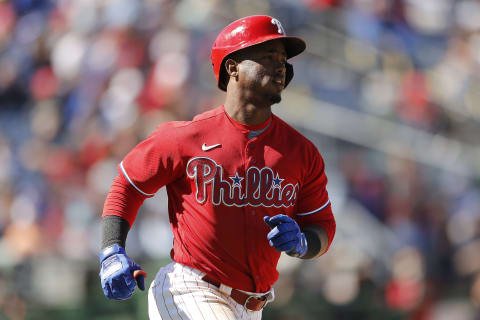
Universal DH: Winners and Losers in the NL
Philadelphia Phillies
The Phillies’ signing of free agent Didi Gregorius to a $14 million deal this past winter made little sense. After all, the Phils were pretty set at short and second with Jean Segura and Scott Kingery.
Or did Phillies’ medical personnel have a unique insight into the playout of the COVID-19 situation that no other team possessed? Because in retrospect, the signing of Gregorius has translated what appeared to be an overstock situation into a DH in the making.
Let Gregorius play alongside Kingery one day, let Segura take over at short the next day, and let Segura slide over to second alongside Gregorius the third day. Whoever’s not playing is DHing.
They’re all capable. Kingery batted .258 in 500 plate appearances in 2019, with 19 home runs. Coming back from an injury, Gregorius only produced a .238 season, but he’s only 30 and that bad year was nearly 30 points below his career average.
Segura? The Phils got a .280 2019 out of him.
And in the event that plan doesn’t work out, the Phillies can probably also work from a surplus of outfield talent. Assuming Adam Haseley fills in as expected in center, joining Andrew McCutcheon in left and Bryce Harper in right, Jay Bruce is more than available to DH. True, Bruce underwhelmed following his acquisition last year from Seattle, but he still has significant power.
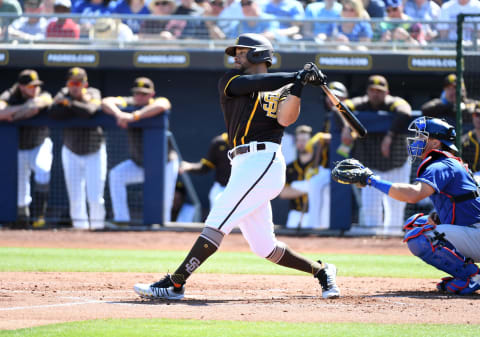
Universal DH: Winners and Losers in the NL
San Diego Padres
The Padres have two logical and obvious DH candidates, and the only issue is working out the playing time arrangements.
On the current depth chart, the team’s corner outfielders are Tommy Pham and Wil Myers. Myers has been an indifferent defensive presence with only modest experience in right, where his range factors have generally rated below average.
That’s why he has spent most of his career at first base or in left field, two positions where defensive is often viewed as optional.
The same can be said of Pham in left, whose primary credential is the ability to hit a baseball, not catch it. Acquired in a trade with Tampa this past winter, he is coming off a season in which he batted .273 with 21 home runs, entirely playable numbers.
The problem is that whoever is stationed between those two in center field would have a lot of ground to cover.
If one of them slides to DH, however, the Padres could try prospects Josh Naylor or French Cordero or trade acquisition Trent Grisham in the outfield, almost certainly bolstering their defense and – if the lucky winner hits – with little to no offensive decline.
Naylor may be the most interesting of those candidates. In 2019 he batted .314 at AAA El Paso.

Universal DH: Winners and Losers in the NL
St. Louis Cardinals
The Cardinals’ solution to the DH question is by no means clear, but it probably involves Matt Carpenter in some significant form or fashion.
Carpenter is a 34-year-old infielder who over the course of his career has displayed two assets. The first is his versatility. He’s played more than 200 games at first base, second base, and third base.
He is, first and foremost, a team player willing to subvert his own pride to do what’s best for the club.
His second asset is a fairly consistent ability to get himself on base. Carpenter’s career on-base average Is .372, 103 points higher than his career batting average. So even when his batting average falls – as it did to .226 in 2019 – he’s still capable of generating respectable offensive numbers.
His 91 OPS+ of 2019 was Carpenter’s first below 120 since 2015.
On that basis, the possibility exists that Carpenter is finished as an offensive force. But assume that he isn’t. Tommy Edman was already pushing him hard for regular playing time at third last year, and the St. Louis depth chart presently lists Edman ahead of Carpenter.
If Carpenter can still swing the bat, he’s a logical fit at DH.
If he can’t, the Cardinals could have issues. They traded away a perfect DH candidate, Jose Martinez, in January, for minor leaguers, a deal they could live to regret. The other legit possibility is Rangel Ravelo, a 28-year-old first baseman stuck behind Paul Goldschmidt.
But Ravelo has only 43 major league plate appearances to his credit, so although he did hit .299 with a dozen home runs at Memphis last year, counting on him involves guesswork.
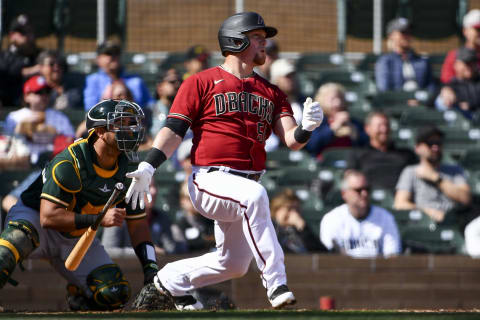
Universal DH: Winners and Losers in the NL
Arizona Diamondbacks
At 5-10, 215 lbs., Kole Calhoun is certainly built like a DH. The Diamondbacks signed him this past winter to a three-year, $23 million free-agent deal to play the outfield, but that plan could be changeable.
In seven seasons with the Los Angeles Angels, Calhoun has never been thought of as a defensive genius. His range factor has generated floated between 1.5 and 2.5, never rising above low-average.
What Calhoun can do is slam the ball. He hit a career-high 33 home runs in 2019, driving in 74 runs.
Shifting Calhoun to DH would leave a gap in the outfield, and the filling of that gap Is not automatic. With Starling Marte and David Peralta set in center and left, the D-Backs could hand the right-field job to prospect Josh Rojas or journeyman Tim Locastro. Rojas has the greater upside, although his 2019 debut – a .217 average in 157 plate appearances – was not in and of itself persuasive.
The other option would be to shift Ketel Marte back from second base to the outfield on a full-time basis. But that would probably force the move of Eduardo Escobar off third base to second or require the D-Backs to rely on Ildemaro Vargas. The latter is an intriguing option, who in 211 2019 plate appearances batted .269, but who has never established the ability to get the job done full-time.
Could Vargas DH? His brief major league resume suggests that strike zone refinements would be in order. He’s carrying a .295 on-base average in 244 career plate appearances, and while that’s a small sample size the raw number is hardly persuasive.
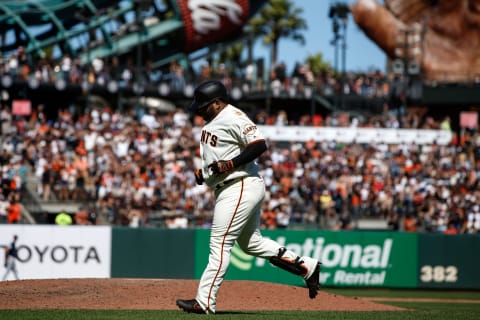
Universal DH: Winners and Losers in the NL
San Francisco Giants
Wasn’t the DH rule made for Pablo Sandoval?
The Giants have spent most of the last 15 seasons trying to figure out what to do defensively with Sandoval, who is now 33 and in the fourth season of his second stint with the team.
Sandoval is now 33 and even panda-lovers recognize that he is a defensive liability. That’s why despite a credible .268 average last season the Giants limited him to fewer than 70 defensive starts, several of those at first base.
Assuming Sandoval has a future, it’s at DH.
He did show offensive potential last season, producing his best numbers since 2013. Those included a .268 average, 14 home runs, and 41 RBIs, all of it adding up to a useful 114 OPS+.
The Giants are rich in guys a bit like Sandoval: aging stars who now need an occasional day off the field. At 33, Buster Posey is one, although using him at DH on any more than a very occasional basis raises the question: who catches?
They also brought back free agent Hinter Pence this winter with the idea of playing him in right field. But Pence is 37, and his defensive numbers have been negative for several years running. On the plus side, Pence did hit .297 for the Rangers last year. The Rangers, it should be noted, sued Pence 46 times as a DH in 2019. That’s a hint.
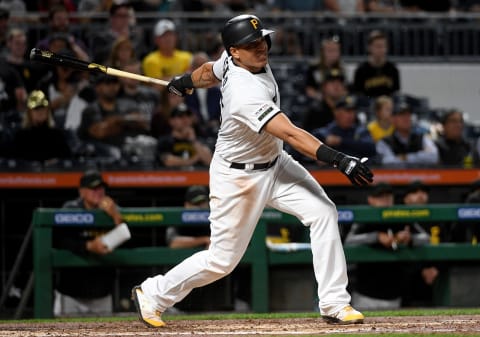
Universal DH: Winners and Losers in the NL
Pittsburgh Pirates
Jose Osuna is a 27-year-old corner outfielder-first baseman out of Venezuela who can hit. In part-time duty last season, he batted .264 with a .456 slugging average.
Although there ought to be playing opportunities in a lineup as talent-starved as Pittsburgh’s, Osuna’s problem is that he plays the only two positions where the Pirates are well-stocked. Josh Bell, the team’s best power threat, is ensconced at first base while Bryan Reynolds, who made a run at the batting title, has left field nailed down.
The logical step, then, is to make Osuna the DH and see what he can do.
The other option is to hand right field over to Osuna and sit Gregory Polanco. But that’s a tough move to make given that the Pirates are committed to Polanco to the tune of $45 million through 2023. True, Polanco suffered through a poor 2019, batting just .242 with six home runs in injury-limited duty. But $45 million is a large commitment anywhere, and particularly in Pittsburgh.
Osuna, then, becomes the first choice at DH.
It’s not out of the question that the Pirates alternate Bell and Osuna at DH and first base, taking advantage of their interchangeability to give one an occasional rest from full-time field duty.
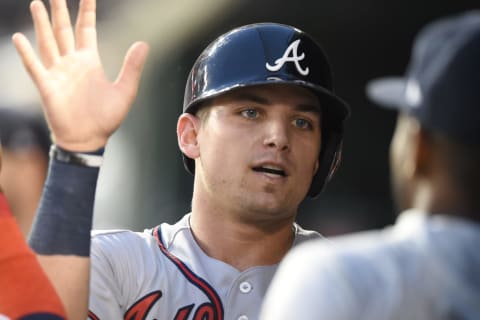
Universal DH: Winners and Losers in the NL
Atlanta Braves
The Braves’ dream scenario is that both of their third base candidates, Austin Riley and Johan Camargo, establish their offensive credentials. Then one plays third and the other DHs.
To date, of course, neither Riley nor Camargo has established those offensive credentials, and it remains entirely possible that neither will. Riley, who is 23, batted .226 in 300 plate appearances in 2019, while Camargo saw his average fall from 272 a year earlier to .233.
If both miss, the Braves have holes at third base and DH.
The other options all involve outfielders. For the moment, Marcell Ozuna, Ender Inciarte, and Ronald Acuna Jr. are the expected starters, but Inciarte’s name has to be written in pencil, given a very shaky 2019 in which he hit only 246.
If Inciarte can’t be counted on, then Acuna moves to center and right field becomes a right – or possibly a platoon — between Nick Markakis and Adam Duvall.
Markakis is a 36-year-old veteran and a proven stick. He batted .285 in 2019 and is a lifetime .288 hitter. Duvall hit .267 in part-time duty. Bu the does have power, having delivered 10 home runs in 130 plate appearances.
Among Riley, Camargo, Duvall, and Markakis, the Braves hope they run into a third baseman, a DH, and maybe an outfielder.
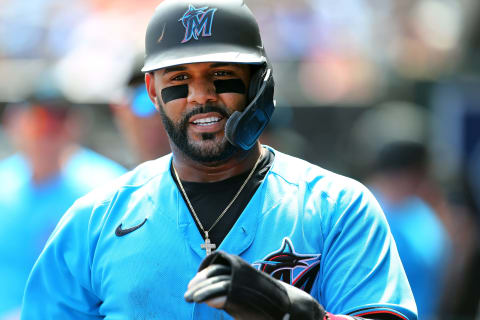
Universal DH: Winners and Losers in the NL
Miami Marlins
The Marlins are so young and untested at so many positions that how they handle the DH situation probably depends on which of their youngsters commands a big playing time upgrade.
Strictly by profile, there are two obvious candidates, both of them veterans.
Jonathan Villar is a 29-year-old veteran the Marlins acquired over the winter from the Baltimore Orioles in exchange for a minor leaguer. Villar’s up-and-down career seemed to gain new traction last season in the low-pressure, low-attention atmosphere of Baltimore, where he played all 162 games and batted .274.
That ought to make him a front-runner at short or second in Miami, and perhaps it does. But if Marlins manager Don Mattingly prefers to test the home-grown talent of the stripe of Isan Diaz, Miguel Rojas, and Brian Anderson, Villar could be a logical DH candidate.
Mattingly does have another option in free-agent signee, Matt Joyce. With Atlanta in 2019, Joyce hit .295 with a .408 on-base average, solid DH credentials.
The biggest drawback to using Joyce exclusively is probably his reputation as a platoon guy. In 2019, for example, the Braves gave the left-handed-hitting Joyce 212 shots against right-handed pitching, but only 26 against left-handers. For his career, Joyce is only a .188 batter against left-handed pitching.
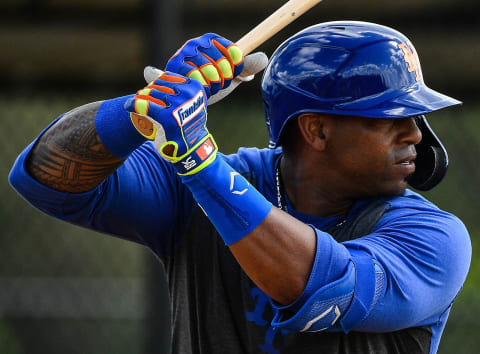
Universal DH: Winners and Losers in the NL
New York Mets
The Mets’ perfect case would involve Yoenis Cespedes returning at least as a DH in 2020.
Alas, the information market on Cespedes’ status basically went dark with the COVID-19-forced mid-March shutdown of camps. All we really know is that Cespedes participated in some team drills in mid-February, but did not play in any spring games. In fact, he hasn’t taken a big-league swing since July 20, 2018.
More from MLB News
- MLB Power Rankings: Atlanta Braves still on top with major shifting below them
- Caesars MLB Promo Code: Two Shots at Picking the World Series Winner!
- MLB Power Rankings: Atlanta Braves still on top amid a big shake-up in top 10
- DraftKings MLB Promo: Bet $5 on an Anytime Home Run, Win $150 Bonus GUARANTEED
- MLB Power Rankings: After MLB trade deadline, gap is closing on Atlanta Braves
Since March, all we have is radio silence.
On the off chance that Cespedes is able to hit by July, breaking him in as a DH would be the obvious step.
If not, the next question the Mets need to ask is whether they’re ready to move Robinson Cano to a less demanding defensive assignment…like none.
Related Story. Will the universal DH rule help Jose Bautista land a job?. light
Cano is signed at $24 million a year through 2024. But he is 37 this summer and has seen his defensive numbers turn negative both of the past two seasons.
For the present Cano remains the designee at second. In part, at least, that’s because the Mets are offensively thin and less capable than many teams of shuffling players to make a DH lineup work.
If they make Cano the DH, they can slide Jeff McNeil into permanent duty at second. But that requires installing J.D. David as the full-time third baseman, and unless Cespedes is ready – that involves counting on Dominic Smith or Jarrett Parker to handle left.
Next. FIVE long overdue rules in MLB's proposal. dark
Leaving Cano at second sends McNeil back to third and Davis to left. But then who DHs? The options appear to be Parker, Smith, Jake Marisneck, Ryan Cordell, or Jed Lowrie, none of them overpowering.